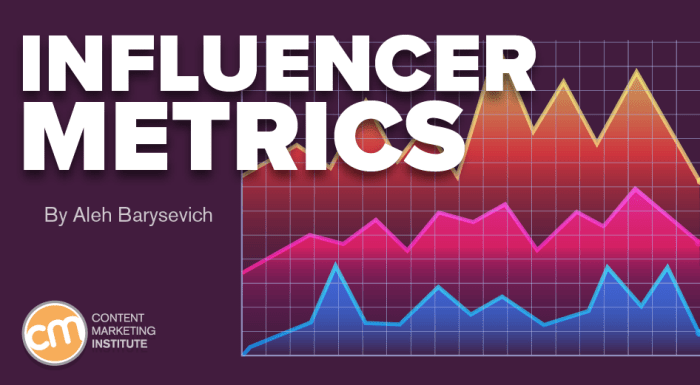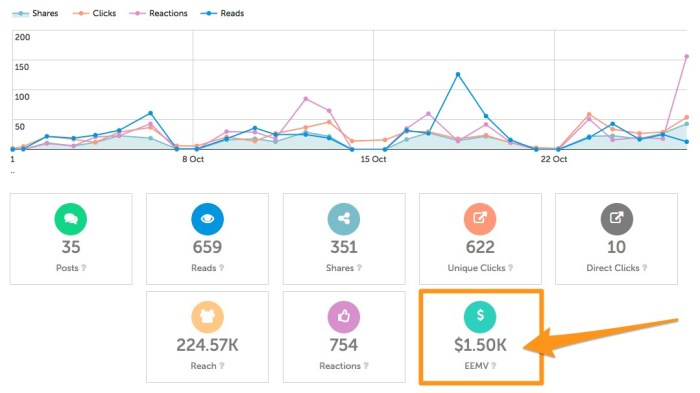Influencer Marketing Metrics take the spotlight in this insightful journey, shedding light on the key to unlocking campaign success with a touch of hip flair.
From understanding the importance to diving into various types and tools, this topic is your gateway to mastering the art of measuring influencer impact.
Importance of Influencer Marketing Metrics
Measuring influencer marketing metrics is crucial for the success of any campaign in today’s digital landscape. By tracking these metrics, brands can effectively evaluate the impact of their influencer partnerships and make data-driven decisions to optimize their strategies.
Evaluating ROI with Influencer Marketing Metrics
- Engagement Rate: This metric measures the level of interaction (likes, comments, shares) that the influencer’s content receives from the audience. A high engagement rate indicates a more active and interested audience.
- Conversion Rate: By tracking the number of conversions (such as sales, sign-ups, or downloads) generated through the influencer’s promotional efforts, brands can calculate the return on investment (ROI) of their influencer marketing campaigns.
- Reach and Impressions: These metrics help brands understand the potential exposure and visibility of their products or services through the influencer’s content, allowing them to gauge the effectiveness of their reach and brand awareness.
Types of Influencer Marketing Metrics

Influencer marketing metrics are essential for measuring the success and impact of influencer collaborations. There are various types of metrics that can provide valuable insights into the performance of influencer campaigns.
Engagement Metrics
Engagement metrics focus on how the audience interacts with the content created by influencers. Examples of engagement metrics include:
- Likes: The number of likes a post receives indicates the audience’s positive reaction to the content.
- Comments: Comments show the level of engagement and interaction between the audience and the influencer’s content.
- Shares: The number of shares demonstrates the content’s reach and the audience’s willingness to spread the message.
Reach Metrics
Reach metrics quantify the number of people who have been exposed to the influencer’s content. Examples of reach metrics include:
- Impressions: The number of times the content has been displayed, regardless of whether it has been clicked or engaged with.
- Views: The total number of views on a video or image post, indicating the level of exposure to the content.
- Unique Visitors: The number of distinct individuals who have viewed the content, providing insights into the influencer’s audience reach.
Conversion Metrics
Conversion metrics measure the effectiveness of influencer campaigns in driving actions and conversions. Examples of conversion metrics include:
- Click-Through Rates (CTRs): The percentage of people who clicked on a link included in the influencer’s content.
- Conversions: The number of desired actions taken by the audience, such as signing up for a newsletter or making a purchase.
- Sales Attributed to Influencers: The revenue generated from sales that can be directly attributed to the influencer’s promotion or recommendation.
Tools for Tracking Influencer Marketing Metrics

In the world of influencer marketing, tracking metrics is essential for measuring the success of campaigns and optimizing future strategies. There are several tools available to help marketers monitor and analyze the performance of their influencer marketing efforts.
Popular Tools for Tracking Influencer Marketing Metrics
- 1. AspireIQ: This platform provides in-depth analytics on influencer campaigns, audience demographics, and engagement metrics.
- 2. Upfluence: Upfluence offers comprehensive tracking of influencer partnerships, performance data, and ROI measurement.
- 3. TapInfluence: TapInfluence allows marketers to track influencer content, reach, and impact on brand awareness.
Comparison of Different Tracking Tools
- Features: While AspireIQ focuses on detailed analytics, Upfluence offers a wide range of tracking capabilities, and TapInfluence emphasizes content reach and impact.
- Capabilities: AspireIQ and Upfluence provide ROI measurement tools, whereas TapInfluence specializes in content performance tracking.
Insights on How Tracking Tools Help in Monitoring Campaign Performance
- Tracking tools allow marketers to measure the effectiveness of influencer partnerships, identify top-performing content, and optimize future campaigns based on data-driven insights.
- These tools enable real-time monitoring of campaign metrics, helping marketers make informed decisions and adjustments to maximize the impact of influencer collaborations.
Best Practices for Using Influencer Marketing Metrics
Influencer marketing metrics are essential for measuring the success of your campaigns and optimizing your strategies. By following best practices, you can ensure that you are effectively using these metrics to drive your influencer marketing efforts.
Setting SMART Goals for Influencer Marketing Campaigns
- Specific: Clearly define what you want to achieve with your influencer marketing campaign. For example, increase brand awareness, drive website traffic, or boost sales.
- Measurable: Set quantifiable goals that can be tracked using specific metrics such as engagement rate, click-through rate, or conversion rate.
- Achievable: Ensure that your goals are realistic and attainable based on your resources, target audience, and influencer partnerships.
- Relevant: Align your goals with your overall marketing objectives and ensure they are relevant to your brand and target audience.
- Time-bound: Set a timeline for achieving your goals to create a sense of urgency and focus for your influencer marketing campaign.
Selecting Relevant Metrics Based on Campaign Objectives
- Engagement Rate: Measure the level of interaction and engagement generated by your influencer content, such as likes, comments, and shares.
- Reach: Evaluate the number of people who have been exposed to your influencer content and assess the potential impact on your target audience.
- Conversion Rate: Track the percentage of viewers who take a desired action after engaging with your influencer content, such as making a purchase or signing up for a newsletter.
- Brand Sentiment: Monitor the overall perception and sentiment towards your brand as influenced by your influencer marketing campaigns.
Interpreting Influencer Marketing Metrics Effectively
- Compare Metrics Over Time: Analyze trends and patterns in your influencer marketing metrics to identify areas of improvement and optimize your strategies.
- Consider Influencer Impact: Evaluate the performance of individual influencers to determine their effectiveness in achieving your campaign goals.
- Adjust Campaigns Accordingly: Use insights from your influencer marketing metrics to make data-driven decisions and refine your future campaigns for better results.
- Focus on Key Performance Indicators (KPIs): Prioritize the metrics that are most relevant to your campaign objectives and use them as benchmarks for success.
